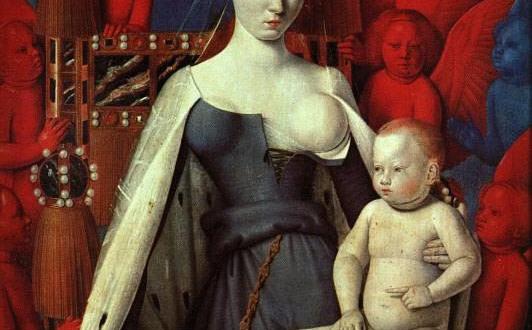Still pondering the fate of the unfortunate Gabrielle, who about this time of year 416 years ago was making big wedding plans.
In February 1599, the king of France, Henri IV had promised to marry her but as mentioned in my previous post, it never happened. On the 9th April she developed stomach cramps and after much suffering, she died. Contemporary descriptions of her final agonies are pretty gruesome – including a self-dislocated jaw – and led to the strong suspicion that she was poisoned. If she was, it would not be the first time that poison had been employed to remove an unwanted mistress.
Something similar had happened 150 years earlier. In 1450 Agnes Sorel, beautiful mistress of Charles VII died at the tender age of 28. Just like Gabrielle she was an influential figure at Court, mother of several royal children already, and pregnant with one more at the time of her death. And, just like Gabrielle, we have reason to believe that she was featured in a most remarkable painting.
Jean Fouquet’s Madonna and Child is a quite sensational piece of art. When you first come across it, it is hard to believe that it was painted as long ago as 1450. It really is quite unlike anything else from that period. The background of interlinking cherubim and seraphim feels much more modern, and that has got to be the hottest depiction of the Virgin… ever.
This painting is one part of the Melun Diptych, it is now in Antwerp and the other panel from the diptych is in Berlin. On that other panel we find the sponsor of this commission, Etienne Chevalier with his patron saint, St Stephen. Chevalier was a rich and powerful man in the French Court, and commissioning a diptych for his home-town cathedral was pretty much what guys like him were expected to do. He had commissioned this in 1450, the year in which he had made a solemn promise to the dying Agnes Sorel that she would be the model for the Madonna.
Gesture of love or guilty conscience?
We now know that poor Agnes did not die of dysentery as it was reported at the time – but that she was poisoned. In 2005, a team of French scientists led by Philippe Charlier exhumed her body and analysed it. They were able to conclude that she had died of mercury poisoning, and although that doesn’t mean she was murdered – people did strange things with mercury in those days – it does make it quite likely.
Her murder, if murder it was, was probably ordered by the dauphin, the future Louis XI who was at war with his father at that time. If so, he needed the help of someone at Court to administer the poison. For a long time Etienne Chevalier was one of the suspects for this crime.
Was having her painted as the mother of God, his way of dealing with his role in her death? Maybe. Another theory is that he and Agnes were lovers, and that the commission was his way of remembering his own beautiful mistress. Of course if this were the case then we should probably add Charles VII to the list of those who might have wanted her dead.
